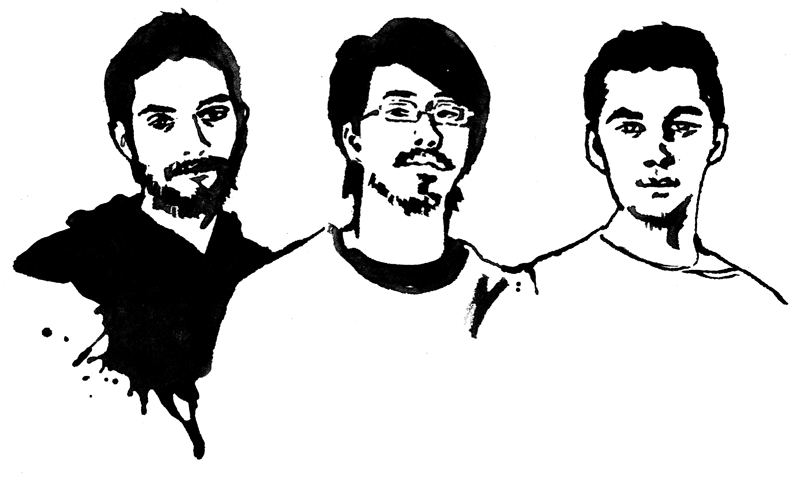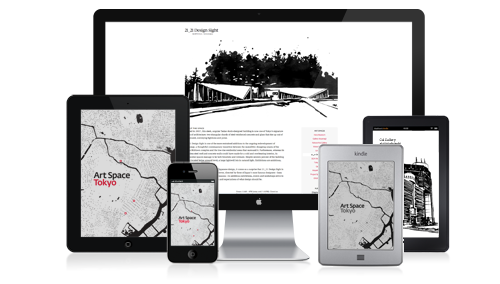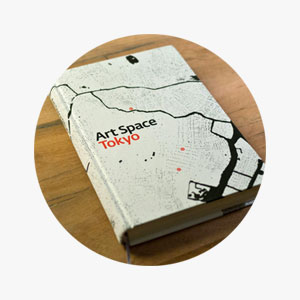Bilingual Tokyo Online
An interview with Paul Baron, Kosuke Fujitaka & Olivier Thereaux
Tokyo Art Beat

PAUL BARON
was born in Paris in 1977. In 2002, he graduated from the London College of Communication and moved to Tokyo. After three years at Honda R&D as an interaction designer, he now divides his time between running Tokyo Art Beat and working at AQ as a usability and information designer.
KOSUKE FUJITAKA
was born in Osaka in 1978. After graduating from the University of Tokyo with a BA in Economics, he worked in the Business Planning Section at Sony Ericsson as financial controller and then as a marketing analyst. As of January 2008, he has been based in New York, where he co-directs NY Art Beat with his wife, Aneta Glinkowska.
OLIVER THERAUX
was born in Rouen in 1977. In 2002, he moved to Tokyo, where he worked for the W3C as a web developer. From 2008 to 2010 he was based in Montreal. Since 2011 he has been living in London, where he is the Senior Technologist at the BBC.
How did the three of you meet and what made you collaborate to create Tokyo Art Beat (TAB)?
PBI had been living in London before coming to Tokyo. With Time Out it was very easy to find galleries in London, but there was nothing similar in Tokyo and very little information in English on the Web. Olivier and I met by chance in 2003 at a DJ party in Harajuku. Some time later we were discussing how we got our information about exhibitions in Tokyo and we realized we were both finding it difficult.
OTRealtokyo.com offered some recommendations, and we had also been getting our art information from AssemblyLanguage.com, which gave a good mix of recommendations of events and locations that weren’t necessarily mainstream, but by the time Paul and I met, that site was dead.
PBhe first emails we have that talk about making this website are from November 2003, just one year before the site went live. We needed a Japanese person to work with to make this project happen and through my cousin I met Kosuke, who was working at Sony Ericsson.
OTWe met a few Japanese people who were gravitating around the project, but nobody had managed to commit to it. However, when Kosuke heard about our plans, he was as excited about it as we were. We had our guy!
How long did it take to make the site?
PBResearch and organization took maybe six months. It was during the summer of 2004 that we designed the site, coded it and entered all the data about venues with a team of volunteers. In September we started inputting exhibition data before our launch in October.
How did you build up the original team of volunteers?
PBIt was all friends and friends of friends, basically. As the project started to grow, more and more people around us got interested. Everybody felt the need for a website like this, so it was pretty easy to find volunteers.
KF Here were two sets of people: casual art goers and people taking art curation classes at Arts Initiative Tokyo. I was studying at AIT and so were several of the people who volunteered for TAB at the beginning.
What are the main principles behind the way you present all this information?
PB The initial goal was to create a database that would contain all information about venues and events and be updated on time.
OT When we first discussed the features we wanted to have, we came up with everything imaginable, but the later stages were about stripping back to the essentials. The fact that we were developing TAB as a side project to our main jobs helped: if we had had a team of ten people and a huge budget, we might have built a super-complicated website...
PB … and it would have been a failure as a result, since we didn’t know all that much about user expectations at the time.
OTSo instead we focused on making something simple and bilingual that wouldn’t be too much work for people to use.
Given that you’re handling such a vast amount of information, why is it so important to you to make it bilingual?
KFThere were no websites as comprehensive as TAB even in Japanese. Other than ART iT magazine, nothing that was going on in Japan was being introduced in English, in any media, so somebody had to take the first steps to promote the Japanese art scene in English.
Why did you decide to run TAB as a nonprofit organization?
OTWe had no money of our own, so we couldn’t pay anyone and knew we’d have to rely on volunteers. We felt the best way to attract volunteers was to make a nonprofit organization in which no one could directly profit from the work of our team. The whole system had to be nonprofit.
PBAll we wanted was to gather information and build a site that is useful for people.
OTAs a result I think we got a better reaction from people, who would work with us out of a sense of greater purpose than financial gain.
KFWe also wanted the website to be neutral and independent.
How do you reconcile the neutrality of TAB event listings with selling banner adverts on the front page, bought by some of the venues listed on the site?
PBTAB is perhaps a little less neutral for galleries or museums taking out adverts on the site, but TAB is just too big to run with volunteers only: we need to pay our core staff. However, we only run adverts that are relevant to our content; we don’t do adverts for hotels and so on. It is true that out of the four hundred or so events that are listed at any time on the website, three or four will get a boost in visitor numbers as a result of having a banner on TAB, but it helps keep the site running, and free, and that in turn helps all the other galleries and museums.
What are you aiming to achieve with the TABlog component of the website?
PBWe set up TABlog to give users another angle from which they can look at what’s out there and decide what they might like to see. The TABlog writers are all volunteers and we ask them to cover a wide variety of venues: big and small, famous and barely known. They aim to cover all different types of exhibitions, artists and media, and there is a fair balance of positive, neutral and critical reporting.
Were you well received by the galleries and museums when you started?
OTOverall, the reactions were very positive. But yes, a couple of museums panicked, wondering what we might be doing with their data. We received faxes with printouts of TAB pages with big red circles all over them!
KFThere were some really finicky requests and a few people who were really suspicious. I remember once having to spend an hour explaining to a gallery owner how we work. These kinds of situations were mostly born out of misunderstandings about the Web. But this kind of thing doesn’t happen any more. That may be because TAB has become very well known, but now people also have a much better understanding of what purpose the Web serves.
How did the galleries and museums react to being mixed together?
KFSome galleries probably don’t like being listed next to rental galleries and art cafés. They care about their quality and the nature of their representation on other media. That may still bother them, but we haven’t heard any comments about it for a long time.
OTWe went against the trends of the time by mixing everything, putting art and design together, and allowing galleries, museums, art cafés, universities and so on to be listed alongside each other according to the area they are in.
PBThe crucial thing here is that our approach is from the user’s point of view; it’s not about whether the art is being shown in a museum or a commercial gallery or a rental gallery, but about the art and helping people get to see it. As people become more and more familiar with the venues out there, of course they will pick up the nuances in each gallery or museum’s outlook, but our fundamental goal is to transcend the art world’s established categories. I think that museums and galleries get smarter when they start to look at things from the user’s point of view.
Have galleries and museums been smart in the way they use the Web relative to your experience in other countries? Is this slowness to get to grips with the Web a Japanese thing, an art world thing, or is it the whole world?
OTIt’s everywhere, not just Japan. In Japan’s case, it’s simply taken a while for many galleries and museums to realize that in order to connect with the world, they need to have a website and that it should be at the very least partially bilingual.
PBWe launched a few months after the Mori Art Museum opened. I think the opening of that museum was quite symbolic of the Japanese art world starting to open up to the rest of the world. Its first two exhibitions were Happiness1 and Roppongi Crossing,2 which were about showcasing the wealth of Asian contemporary art to the rest of the world. Suddenly within Tokyo, people realized that they were part of a global market, not just a domestic one. Our website came out at the right time.
How can TAB improve, and what is the future potential for the Web in Tokyo’s art world?
OTThe Internet trend right now seems to be a fear of big sites like Google and Facebook, which offer so many services but are gathering a lot of power, potentially abusing people’s personal information. I’d like to think that the future of the Internet is one in which there will be more sites and more services catering to local people. It wasn’t really our strategy to aim at the niche of the Tokyo art world — it just happened that we were part of that crowd and that people needed what we were providing.
KFAnother way of looking at it is that TAB physically connects people; it doesn’t just exist on the Web. You search for the information you want and then you act on it and go and see an exhibition.
PBThe future potential for the Web in Tokyo’s art world is simply to have more bilingual websites. Recently we counted how many of our seven hundred venues have bilingual websites, and it’s only thirty percent of them!
Kansai Art Beat launched in April 2007, and you plan to launch New York Art Beat in April 2008. What did you get out of the experience of helping KAB launch and how will new Art Beat sites have to adapt to their cities or regions?
OTThe real test for cultural adaptation will be in New York, because the experience of launching Kansai Art Beat was still within Japan. The venue types or the information about how to get somewhere on KAB are still presented in a manner that is specific to the Japanese context.
PBUnlike New York, Tokyo doesn’t really have art neighborhoods. These neighborhoods were not a part of how we built TAB, so we will have to adapt the site for New York, although our model was fundamentally designed to work anywhere. There are already websites in New York that do some part of what TAB does, so there’s also the challenge of how we will fit in. We’re aware that New York Art Beat could be perceived as an invasive presence, especially if it turns out to be more popular than the sites that are already there. We will probably tread on more toes in New York than in Tokyo, but if that’s the price to pay for giving people good information, so be it.
KFI think that of course it’s important for any Art Beat to be up to date and easy to use, but more importantly, it should have the people behind it putting a face on it; whatever city it may be, the people running the website have to go out and be an active part of the art scene. The blog is another way of giving the website a more personal and accessible feel to people who are new to the scene.
PBAnother aspect is that in a way we’re not opening in New York as New Yorkers, rather we’re opening as New York Art Beat from Japan. The top of the homepage will link to Tokyo Art Beat and Kansai Art Beat, so people will view us more as a website that came from abroad. It’s going to be funny to see how New York reacts to this site from a ‘third world’ art market moving onto its turf and setting a new standard. Hopefully the ‘Japan cool’ element will help.
Noted
- Happiness: A Survival Guide for Art and Life was held from October 18, 2003 to January 10, 2004. This exhibition featured around 250 works by approximately 180 artists, from all genres and periods.↩
- Roppongi Crossing: New Visions in Contemporary Japanese Art 2004 was held from February 7 to April 11, 2004. This exhibition brought together sixty Japanese artists working in a broad range of media.↩
UPDATE
After a just over year of operation, Kansai Art Beat was put on hiatus on July 1, 2008.

